Exploring Curve Building in Dubai's Real Estate Market
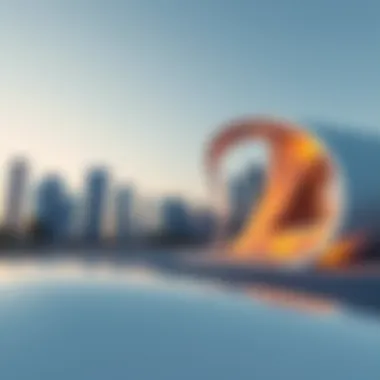
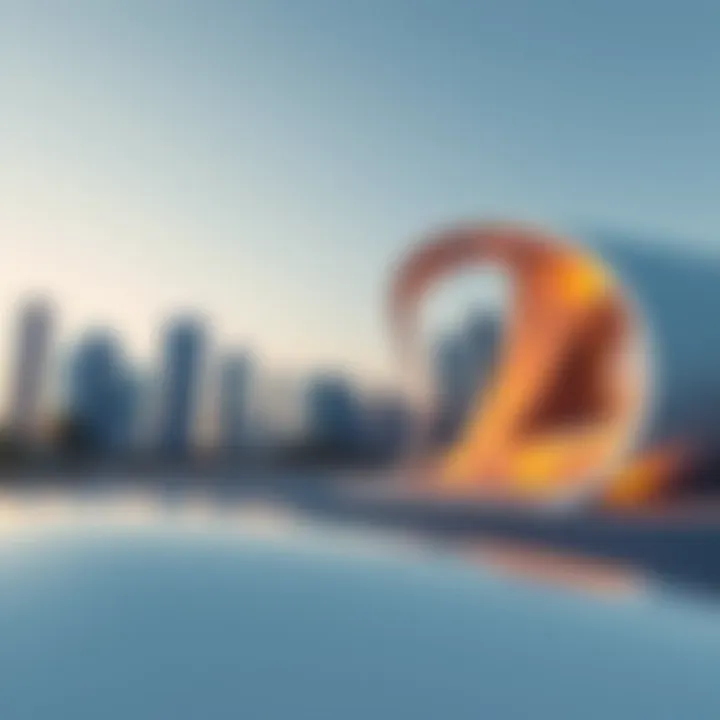
Intro
In the shadow of the shimmering skyscrapers and sweeping landscapes of Dubai, an architectural revolution quietly unfolds. Curve building has emerged as a fundamental design language, redefining urban spaces and sculpting the future of real estate in this vibrant city. More than just a trend, the adoption of soft, flowing shapes signifies a pivotal shift in how we conceive of residential and commercial environments. These architectural forms do not merely serve aesthetic purposes; they symbolize a broader philosophy towards living and community integration, enhancing the overall experience of those who inhabit or invest in these spaces.
As property developers race to create distinctive and lifestyle-driven projects, understanding the dynamics behind curve building becomes paramount for investors, homeowners, and real estate agents. This article will dissect how these innovative designs impact property values, influence buyer perceptions, and ultimately shape the urban landscape. With a detailed examination of current property trends and practical buying guides, this narrative is tailored for discerning audiences who seek to navigate the multifaceted world of Dubai real estate.
Throughout, we will blend insights with real-world examples, striving to present a comprehensive view of a market that is as much about art as it is about commerce. Curves in architecture may seem like a simple visual choice, but their implications reach far deeper, weaving into the social fabric and economic framework of the Emirate. Welcome to an exploration of Dubai’s curve building – where design meets dynamic living.
Preamble to Curve Building
Curve building isn’t just a passing trend in the architecture of Dubai; it stands as a testament to innovation and creative expression. This section aims to peel back the layers, illustrating why the concept of curve building is essential for anyone involved or interested in Dubai's real estate market. Whether you're an investor, a homeowner, or a developer, understanding curve building offers significant insights into the region's evolving landscape.
By integrating curves into architectural designs, buildings are not only transformed aesthetically but also functionally. They allow for better flow of space and light, fostering a sense of tranquility that often gets lost in more rigid designs. The benefits can be profound: increased property value, enhanced quality of life, and a stronger sense of community. Moreover, the unique lines and shapes draw potential buyers and tenants in, appealing to their desire for modernity and luxury.
In sharp contrast to boxes and straight lines, curves create unique silhouettes that can easily become iconic landmarks. It’s also worth noting the psychological effect; spaces with flowing lines often feel more welcoming. This emotional response matters, especially in a fast-paced city like Dubai, where buyers and tenants still yearn for a sense of home. Understanding curve building thus involves considering both tangible and intangible aspects that benefit owners and investors alike.
Defining Curve Building
So, what exactly do we mean by curve building? Essentially, it refers to architectural designs that break away from traditional linear forms. Rather than straight walls and box-like structures, curve buildings incorporate rounded edges, swooping lines, and fluid shapes. This approach to design creates not only visually appealing homes and offices but also enhances functionality. For instance, windows can be-oriented more strategically for better lighting. In today’s real estate landscape, curve-building defines not just physical structures but also the psyche of a modern urban dweller.
The allure of curve building resonates strongly with individuals looking to make statement purchases. It indicates a lifestyle choice, connecting modernity with comfort in a unique blend. Therefore, in the Dubai context, it is indispensable.
Historical Context
Understanding the historical backdrop of curve building adds depth to its significance. Dubai, which rapidly transformed from a modest fishing village to a modern metropolis, began to embrace innovative architectural styles in the late 20th century. This shift coincided with the global rise of modern architecture that celebrated unusual forms and organic shapes. As architects like Zaha Hadid and Frank Gehry gained prominence for their avant-garde designs, the idea of curves began to infiltrate the local market.
In Dubai specifically, several developments utilized curve building as a means to set themselves apart amidst fierce competition, where every developer sought a unique selling proposition. Take the Burj Al Arab, for instance; its distinctive sail-like shape embodies the essence of Dubai's ambition and luxury. This pioneering approach opened doors for countless other projects, encouraging local architects to experiment further with curvature as a means to both attract attention and celebrate artistic freedom in design.
Thus, the historical journey of curve building in Dubai not only mirrors global architectural tendencies but also reveals an intrinsic quest for identity within the region’s relentless drive for progress.
Architectural Significance
The architectural significance of curve building cannot be underestimated, especially in a vibrant market like Dubai. Curves have a unique ability to convey motion and fluidity, setting them apart from traditional angular designs. This aspect not only attracts attention but also enhances the aesthetic value of properties, making them standout in a crowded real estate landscape. As this city continually evolves, the impact of curves shapes public perception and influences both residential and commercial developments.
Aesthetic Appeal
Curves in architecture offer a refreshing deviation from conventional straight-line designs. They invite a sense of harmony and elegance, appealing to the emotional side of prospective buyers. For instance, buildings like the Burj Al Arab harness curves to create a visually arresting skyline. The use of curves allows for greater variability in building shapes, creating designs that can express unique identities.
When intentional, these curves can draw the eye upward, making spaces feel more expansive and open. This plays a critical role in urban environments where efficient use of space is necessary. Visually stunning structures naturally spark curiosity, encouraging footfall and creating vibrant public spaces. Investors are continuously seeking out properties in neighborhoods enriched by such innovative designs, driving demand and potentially increasing property values.
Moreover, the interplay between curves and light creates dynamic shadows and reflections that enhance a building's visual appeal throughout the day. This adaptability tells a narrative of change, a theme that resonates deeply within Dubai’s culture of progression and ambition.
Structural Implications
The structural implications of curve-based designs warrant a serious discussion. While they may appear whimsical, curves require careful engineering to ensure stability and safety. This type of design can incorporate advanced materials and techniques, embracing cutting-edge technologies such as computer-aided design and advanced structural analysis. As a result, buildings are not only visually captivating but also resilient.
For developers, considering these advanced designs is crucial. Curved structures can face higher construction costs due to the need for specialized labor and materials. Investors should be mindful of this when evaluating potential projects. However, when executed well, the structural uniqueness can lead to an increase in property value over time.
"Investing in curve-designed buildings is not merely about aesthetics; it incorporates smart engineering that forecasts longevity and resilience," notes an architect specializing in Dubai's skyline innovations.
To summarize, the architectural significance of curves in Dubai encompasses aesthetic enhancement and complex structural considerations. The balance between these elements provides insight into the changing dynamics of real estate in the region, impacting not just investors but also future city dwellers who will inhabit these innovative spaces.
Influence on Urban Development
The incorporation of curve building into Dubai's real estate development carries substantial weight. Not merely a design choice, the curves contribute to the overall urban fabric, fostering a sense of identity and community within the fast-evolving landscape of the city. This transformative architectural approach facilitates more than just physical structure; it emphasizes the human experience in urban environments.
One of the primary benefits of this approach is the promotion of community integration. Curvilinear designs encourage social interaction, creating spaces where residents and visitors alike can gather and connect. For instance, curved pathways and landscaped areas can inspire a more pedestrian-friendly environment, allowing people to meander through neighborhoods rather than having to rely solely on vehicles. By thoughtfully constructing these designs, developers contribute positively to the urban ecosystem, fostering inclusivity.
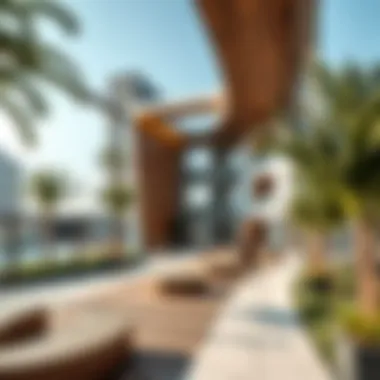
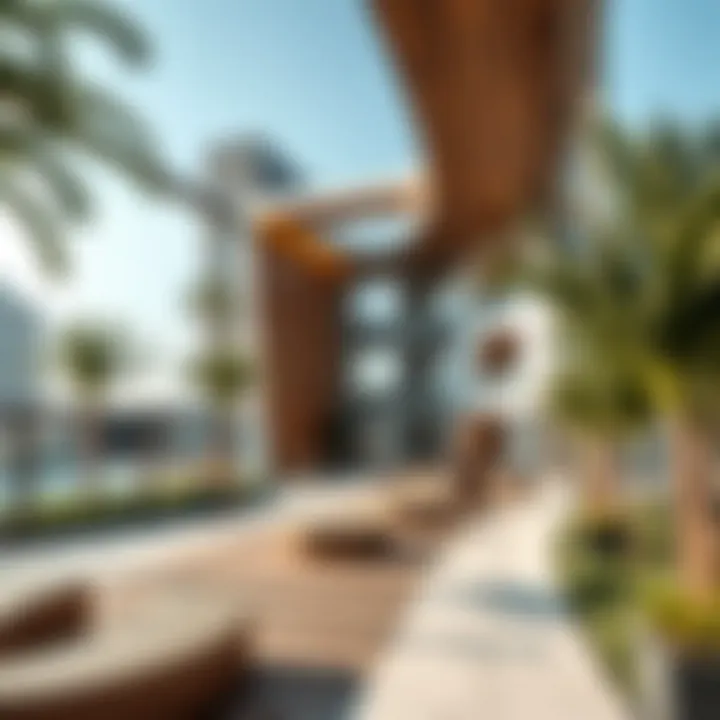
Moreover, curvaceous structures often have a more compelling visual appeal. They break from the monotonous, rigid lines traditional buildings tend to display. This aesthetic variation attracts not only potential buyers but also tourists, further enhancing the vibrancy of the area. As seen in landmark structures like the Burj Al Arab, the allure of unique architecture reinforces Dubai's status as a global leader in innovative design. Successful communities are often defined by their architectural uniqueness, and curves play a significant role in this identity.
Community Integration
Curves have a way of blending in with the natural landscape. This integration creates harmony between the built environment and the surrounding nature. When residential complexes incorporate soft curves and organic shapes, it effortlessly merges the development with existing parks or scenic views, facilitating a natural flow that engages the community. Curves can also help facilitate greater accessibility in the urban landscape, minimizing barriers that arise from traditional, angular designs. The reduction of sharp angles in urban planning allows for easier navigation, particularly for families with children, the elderly, or those with disabilities.
The social dynamics within such environments thrive, as communal spaces designed with curves invite people to spend time together. An example of a successful implementation of curve design can be seen in the Dubai Marina, where twisting pathways invite strolls along the waterfront, establishing a sense of belonging among residents. Curved streets and open areas encourage exploration, leading to spontaneous interactions, further cementing community spirit.
Enhancing Public Spaces
Curved architecture plays a critical role in enhancing public spaces throughout urban development. When these designs are implemented thoughtfully, they contribute to creating visually striking landmarks that serve as focal points for city dwellers. Public spaces enhanced by curves encourage community engagement and uplift the experience of the environment, making them inviting to both residents and tourists.
Enhancements in public parks often involve curvilinear designs that provide pleasing aesthetics alongside functional spaces. For example, the Dubai Design District utilizes curves to create open areas conducive to art installations, outdoor performances, and social gatherings. These curved elements break the rigidity often found in urban design, promoting exploration and admiration of the environment.
Curvaceous structures don’t merely alter the skyline; they redefine how urban landscapes are experienced and interacted with.
Urban planners and architects are encouraged to consider the possibilities that such innovative designs present. More engaging public spaces can lead to increased foot traffic, boosting local economies and supporting businesses in the vicinity. Moreover, properly integrated curves can mitigate environmental impacts, allowing for sustainable development in harmony with nature.
In summary, the influence of curve building on urban development extends well beyond aesthetics. It creates a framework for community integration and public space enhancement. As Dubai continues to evolve, these architectural choices provide a robust foundation for the city’s character and identity.
Market Trends in Dubai
The real estate market in Dubai has evolved significantly, revealing nuances that shape both investment potentials and lifestyle preferences. As cities become more globalized, understanding local trends is crucial for stakeholders including investors, homeowners, and real estate agents. In this dynamic environment, the concept of curve building plays a pivotal role in shaping market trends.
The adoption of curves in architecture is not just a matter of aesthetics; it reflects a deeper yearning for innovative living spaces. The flowing forms of buildings evoke ideas of modernity and sustainability, resonating with contemporary buyers. Highlighting the importance of these trends allows us to grasp how they impact property valuations and the overall landscape of Dubai's real estate.
Emerging Preferences
In recent years, buyers in Dubai have shown a distinct tendency towards properties that showcase fluid, organic designs. This is partly influenced by changing demographics, with a new generation entering the housing market who prioritize lifestyle aspects over traditional values.
These emerging preferences can be seen in various ways:
- Sustainability: Environmentally conscious choices play a key role in what consumers want. Developers are increasingly integrating sustainable practices into curve building, making energy-efficient designs a selling point.
- Lifestyle Integration: Homes and apartments featuring curves often complement outdoor spaces, enhancing community feel. Buyers tend to gravitate towards properties that foster connections with surroundings.
- Technological Integration: Curved designs often accommodate modern technology better, allowing for smart home integrations that appeal to tech-savvy buyers.
Much of this transformation in preferences seems tied not only to aesthetics but also to functional living. Young professionals and families are on the lookout for spaces that fulfill both needs for modernity and comfort.
Influence of Design on Property Values
The way a property is designed, particularly with regard to curves, can have a substantial effect on its market value. Buyers evaluate potential homes not only based on square footage or location but also on perceived emotional and psychological value derived from the architecture.
Research indicates that:
- Higher Demand for Unique Structures: Properties designed with curved features often see increased interest and can attract a premium price. The uniqueness of such designs adds to the desirability.
- Market Fluctuations: In a fluctuating market, the aesthetic appeal provided by curve designs can serve as a buffer against depreciation. Innovative architecture tends to stand out, even during downturns.
- Reputation of Developers: Developers known for successfully integrating curves into their designs often elevate their brand’s standing, leading to higher valuations across their portfolios.
"The influence of innovative architecture in Dubai not only enriches the cityscape but also enhances the allure of residential offerings for potential buyers."
Impact on Buyers’ Perception
In the realm of Dubai's real estate market, the way buildings look can significantly shape buyers' perceptions. Curve building, with its sinuous forms and organic lines, stands out against the more rigid, traditional straight-edged designs. Among the forefront of architectural trends, this approach not only alters the skyline but also influences how potential buyers and investors see value in properties. The aesthetics often elicit emotional responses, leading to a deeper connection. Let's unpack this further.
Psychological Aspects of Design
When people view buildings, they are not merely assessing square footage or amenities. The psychological impact of design elements plays a crucial role. Curves can evoke feelings of softness, comfort, and warmth, in contrast to harsh angles that can feel imposing or cold. People often relate curves to concepts of health and vitality, making them more appealing in residential spaces where families seek nurturing environments.
Moreover, there is a psychological phenomenon called the "Gestalt Principle" which suggests that individuals see objects as whole forms rather than merely as collections of individual parts. Curvilinear designs can create holistic impressions, making a property seem more inviting and complete. These design choices resonate particularly well in a city like Dubai, where luxury and comfort are paramount considerations for buyers.
Another interesting aspect relates to brand perception. For developers, associating their properties with cutting-edge design can position them favorably among competitors. A buyer’s choice is influenced not just by the property itself but by the perceived prestige that comes with owning a uniquely designed space. This scenario creates a major sway on how properties are marketed and sold, affecting everything from pricing strategies to investment reasoning.
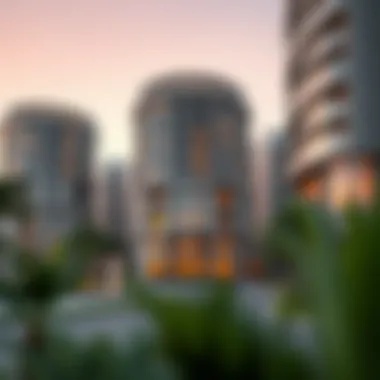
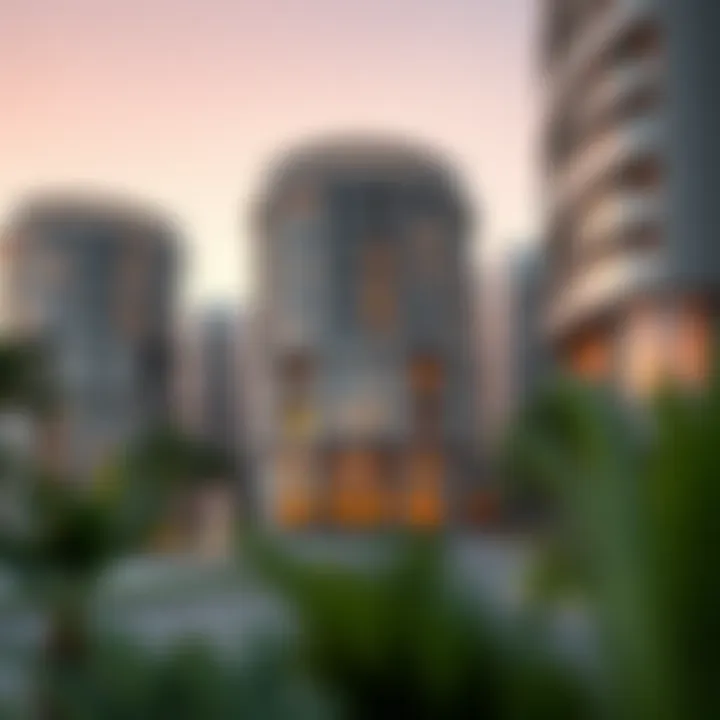
Curves and Consumer Appeal
The appeal of curves extends beyond psychological satisfaction; it speaks directly to consumer behavior in the real estate market. In many ways, curves have become synonymous with modernity and innovation. Properties featuring this architectural style command a certain allure that attracts potential buyers, particularly those looking for something that reflects a rich, vibrant lifestyle.
"Curves are not just about looks; they signify a shift in how communities and homes can blend into the environment, creating not just structures but experiences."
In sales pitches, many agents leverage this attraction to highlight aspects of lifestyle and well-being. Properties with smooth, flowing designs are often marketed as havens of relaxation, integrating seamlessly with Dubai's lifestyle of leisure and richness. This association enhances perceived value and offers a strong selling point for buyers who prioritize aesthetics in their home search.
Additionally, properties that employ curves are typically positioned as trendsetters. Buyers feel they are part of a forward-thinking movement by choosing homes that break from conventional design molds. This forward-facing perspective can sometimes lead to premium pricing, as people are willing to pay more for something that stands out and feels ahead of its time.
Challenges in Implementation
The intricacies of curve building in Dubai real estate are vast, yet they come bundled with a unique set of challenges that must be tackled head-on. In such a rapidly developing city, where architectural aspirations soar to unprecedented heights, it’s crucial to recognize both the hurdles and potentials that come with implementing these innovative designs.
Technical Barriers
The first hurdle lies within the technical barriers that curve buildings naturally present. Constructing a structure with a sweeping curve is not just a matter of aesthetic appeal but demands advanced engineering skills. Architects and engineers need to collaborate closely, integrating innovative materials and construction techniques that accommodate non-linear shapes.
- Material Constraints: Traditional building materials may not suffice to support the unique forms of curve structures without added reinforcement. This can increase overall cost and complexity.
- Engineering Expertise: Such designs often necessitate specialized knowledge in structural engineering to ensure safety and stability. This requires skilled professionals who might not always be readily available in the local talent pool.
- Complex Design Processes: Designing for curves involves computational techniques like parametric modeling, which can complicate the drafting process, elongating timelines and increasing costs associated with design changes.
Due to these factors, there may be instances of missed deadlines or budget overruns, creating a ripple effect that impacts investors, homebuyers, and developers alike.
Regulatory Considerations
Navigating the regulatory landscape can considerably complicate the implementation of curve buildings. In Dubai, where development is both swift and extensive, regulatory frameworks may not always keep pace with architectural innovation. The approval process for unconventional designs can become lengthy and fraught with uncertainty.
- Zoning Laws: Curve buildings may face challenges when it comes to existing zoning regulations. Adjustments to land use policies might be necessary to accommodate these designs.
- Building Codes: Dubai has stringent building codes focused on safety and resilience. Often, curve designs must meet unique criteria that traditional buildings do not, leading to extended approval processes.
- Public Reception: The local community's perception of unusual architecture can also affect implementation. If a design is not well-received, securing the necessary approvals can become a challenging task.
To sum up, while the allure and potential of curve buildings in Dubai are undeniable, diving into their implementation requires thoughtful navigation of technical and regulatory challenges that can easily trip up even the most committed investors and developers.
International Perspectives
The international perspectives on curve building offer a crucial lens through which to view its implications in Dubai's real estate landscape. By examining different cultural and architectural approaches globally, one can gain insights into how curves are perceived and integrated into urban environments outside the Gulf region. This exploration not only illuminates the aesthetic brilliance of curve-driven designs but also underscores practical applications that impact functionality and sustainability.
Different regions bring unique philosophies about architectural design, influenced by cultural values and environmental considerations. For instance, in cities like Amsterdam, the gentle curves of canals and the iconic round buildings maximize space utilization while enhancing the visual flow. Similarly, Tokyo’s blend of tradition and modernity shows how curves can facilitate a seamless connection between diverse elements in urban living.
Benefits of International Perspectives:
- Innovative Design Solutions: By analyzing curve patterns utilized in other cities, Dubai’s developers can draw inspiration to tackle local challenges such as space constraints and urban aesthetics.
- Sustainable Practices: Global practices in curve building often incorporate eco-friendly materials and methods, fostering sustainability which is essential for long-term urban growth in Dubai.
- Cultural Integration: Understanding how curves resonate with different cultures can aid in crafting spaces that feel inclusive and welcoming for a diverse populace.
Comparative Studies
Comparative studies illustrate how curve building manifests differently across cultures, shaping not only the skyline but the lifestyle within these cities. For instance, the high-rise buildings in Manhattan often favor rigid, vertical designs to optimize land use, whereas cities like Barcelona embrace organic forms that echo the surrounding landscapes. Such studies reveal that design trends are not just cosmetic; they often reflect deeper societal priorities.
In Dubai, the Burj Al Arab stands as a testament to daring design, with its sail-like structure symbolizing the city’s aspirations. Looking at La Sagrada Familia in Barcelona, its intricate curves blend architecture with natural forms, evoking a sense of harmony.
- In both cities, the curvature of buildings has become influential in establishing identity — Dubai as a symbol of modern ambition and Barcelona as a hub of artistic heritage.
Best Practices from Global Markets
Learning from global successes can pave the way for Dubai to refine its curve building practices. These best practices involve a mix of aesthetic, structural, and economic considerations that can lead to successful developments.
- Emphasizing Functionality: Curved structures must not only look good but also serve their intended purpose efficiently. Designs should facilitate natural movement, light, and airflow to enhance the living experience.
- Adaptive Reuse: Cities like London have successfully converted older, more traditional structures into modern, curved forms, breathing new life into them while preserving historical significance. Local developers could explore similar strategies.
- Community Engagement: Implementing curve designs that respond to the needs of local communities can foster a sense of ownership and belonging. Public spaces that feature gentle curves often encourage social interactions and enhance livability.
“Understanding how curves engage with the human experience is vital for architects and developers striving to create spaces that inspire.”
Case Studies in Dubai
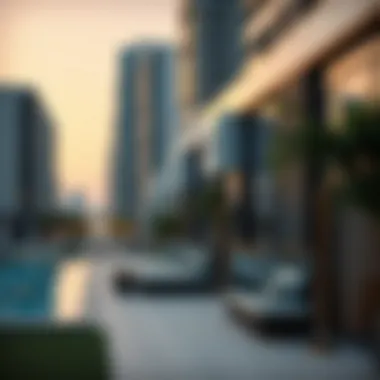
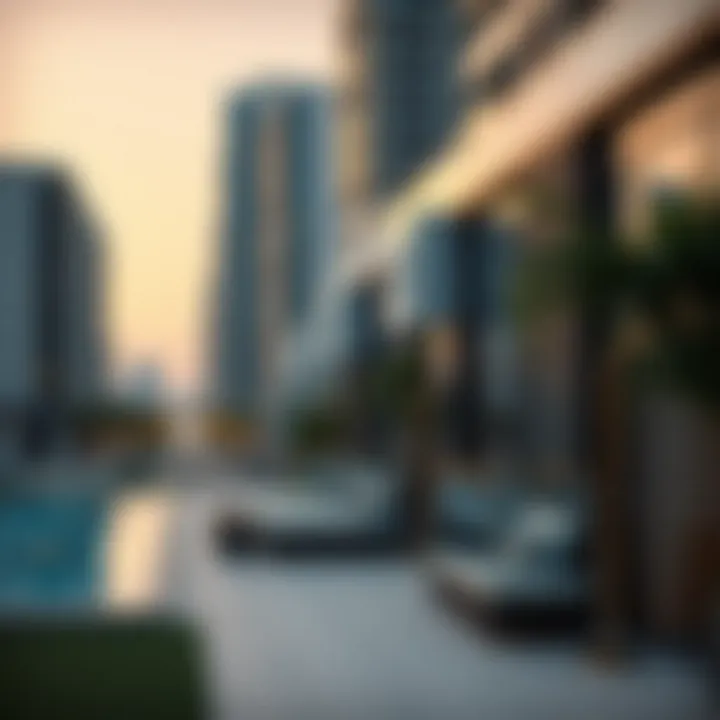
Exploring the realm of case studies in Dubai provides invaluable insights into how curve building influences the real estate market. These specific examples highlight not only the architectural marvels that curve design brings but also the economic and social impacts associated with such developments. Understanding these case studies allows investors, homeowners, real estate agents, tenants, and developers to grasp what makes a property appealing in this trend-driven market. Crucial elements include the integration of curves in design, the reception by buyers, and the resultant property valuations.
"Real estate is not just about buildings; it's about creating valuable and practical spaces that resonate with the community."
Iconic Developments
Dubai has become home to several iconic developments that showcase the elegance and practicality of curve building. This approach is prevalent in structures such as the Burj Khalifa, where its smooth lines ascend to the sky, creating a visual narrative of progress and luxury. The Dubai Marina, with its undulating skyline and waterfront properties, encapsulates how curves enhance aesthetic appeal while providing functional living spaces. Each of these developments serves as a testament to the viability of curve design in urban architecture, attracting various demographic groups.
A few notable examples include:
- The Opus: This unique hotel by Zaha Hadid embodies seamless curves, making it visually captivating while offering top-notch hospitality services.
- AquaHouse: Situated at Dubai Hills, AquaHouse features flowing forms inspired by the natural environment, integrating biophilic elements into modern living.
These structures are not mere edifices; they are art pieces contributing to the life of the city, fostering community interaction and enhancing property values.
Lessons Learned
From these groundbreaking case studies, several lessons emerge about the dynamics of curve building:
- Community Engagement: Successful projects tend to engage with the community through participatory design. Tailoring curves to meet local needs ensures that developments aren't just striking but also functional.
- Market Adaptability: The fluidity of curve design allows developers to adapt to shifting market preferences effectively. This flexibility is key as Dubai's real estate sector evolves rapidly.
- Sustainability: Curved designs often promote sustainability by utilizing natural light and airflow, creating energy-efficient structures that are appealing to environmentally-conscious buyers.
- Investment Potential: Properties that incorporate innovative designs tend to have a higher and more stable property value over time. Investors find these designs attractive due to their uniqueness and the solid market demand.
By examining these lessons, stakeholders in Dubai's real estate market can better understand the lasting impact of creative architectural designs. Such insights serve as a guide for future projects, emphasizing the important role curves play in fostering both community and economic growth.
Future Directions
As we stand on the cusp of transformation within Dubai's real estate sector, the importance of understanding the future directions of curve building cannot be overstated. This concept is not merely about aesthetics—it's about how these architectural forms can guide urban planning, cultural identity, and investment strategies. Curve building symbolizes a new era, where the elegance of design meets the pragmatic needs of sustainability and community.
The following sections will examine two critical components in this narrative:
Innovations in Architecture
In recent years, there has been a noticeable shift toward innovative architectural practices in Dubai. The integration of cutting-edge technology into building design is reshaping the way we think about residential and commercial spaces.
- Sustainable Materials: The use of eco-friendly materials not only reduces the carbon footprint but also enhances the durability of buildings. Materials like self-healing concrete, which can repair its own cracks, are becoming more common. This is not just about reducing maintenance but also about changing the way we view our built environment.
- Smart Home Integration: With homes equipped with IoT technology, residents can manage lighting, climate control, and security from their smartphones. Curved designs lend themselves beautifully to these features, creating seamless integrations that enhance user experience.
- Biophilic Design Principles: Incorporating nature into architecture provides psychological benefits to residents. Buildings designed with curves tend to attract natural light more effectively, reducing dependency on artificial lighting and promoting well-being.
"Innovation is the ability to see change as an opportunity—not a threat."
The future of curve building lies in enhancing both form and function, making it essential for architects and developers to keep an eye on emerging trends that prioritize community needs and environmental impacts.
Projections for Urban Growth
When we look at projections for urban growth in Dubai, curve building plays an integral role in accommodating the increasing population and evolving urban landscape. Taking into account current trends, here are a few key considerations:
- Infrastructure Development: With the city's strategy focusing on sustainable urban development, there will be a surge in infrastructures that complement the curvature in designs. Roads, public transport, and amenities will converge at these architecturally significant points, facilitating easier access.
- Increased Land Value: Properties featuring innovative designs typically see a significant appreciation in value. Investors who recognize the potential of curve building will likely position themselves favorably in Dubai's evolving landscape.
- Resilience to Climate Change: Buildings designed with curves can better withstand harsh weather conditions, making them particularly suited to the regional climate. As the concern for climate resilience grows, these designs will become more integral in future development plans.
Closure
The conclusion of this article brings to light the myriad ways in which curve building dramatically reshapes Dubai’s real estate landscape. This insightful exploration into the architectural nuances elucidates how curves are not merely aesthetic choices but pivotal elements influencing urban living, community integration, and property value.
One cannot overlook the significance of curve architecture in fostering unique identities for various neighborhoods, setting them apart as sought-after destinations for both residents and tourists alike. The appeal of a well-designed curved structure can significantly sway buyer perception, creating a sense of intrigue that mere straight lines cannot achieve.
Summative Insights
In summation, the impact of curves extends beyond mere visual allure; it encompasses several critical aspects:
- Psychological Influence: Curves can evoke feelings of comfort and tranquility, making properties more inviting.
- Cohesion with Environment: They often blend seamlessly with the surrounding landscape, enhancing the overall urban aesthetic.
- Increased Property Value: Uniquely designed buildings can lead to a rise in demand, thereby boosting investment returns for owners and developers.
Curves in architecture are not just shapes; they are symbols of creativity and innovation. They redefine spaces, making them livable and enjoyable.
Call for Further Research
Despite the insights shared, there is still much to learn about the implications of curve building in various contexts. Future research could explore:
- Comparative Analysis: Studying how different cultures respond to curved versus angular designs would provide a broader perspective.
- Sustainability Impacts: Investigating how curved designs can contribute to sustainability in urban areas could drive further innovations.
- Longitudinal Studies: Tracking the long-term effects of curved architecture on community satisfaction and economic prosperity in Dubai.
In closing, the dialogue surrounding curve building remains vibrant and essential. It beckons investors, developers, and urban planners to further engage with the evolving trends, positioning Dubai not just as a hub of architectural delivery but as a pioneer of modern living spaces.













